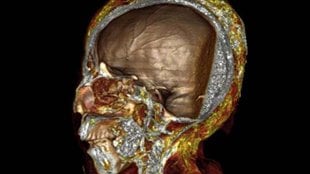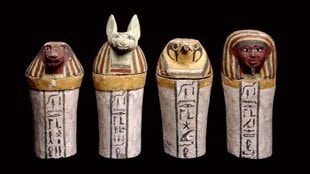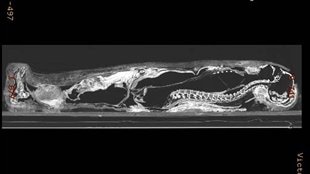We are still fascinated by mummies.

brain cavity may have a connection to the sun and
divinity © Elsevier-JAS
In the western world, we are often also somewhat squeamish about the idea, which some might consider rather grisly.
Yet, mummification has been practiced by many cultures around the world, and some even into relatively recent times.
A Canadian team of Andrew Nelson and Andrew Wade has been studying mummies, and compiling a database of radiographic studies of Egyptian mummies, which facilitates the systematic study of Ancient Egyptian mummification techniques.
Dr. Andrew Nelson is an associate professor of Anthropology, and Associate Dean (Research & Operations) in the Faculty of Social Science at The University of Western Ontario.
Listen
For much of the past couple of centuries, most of what we knew about Egyptian mummification techniques came from a description by Herodotus a 5th century BC, Greek historian, and much later by another Greek historian Diodorus in the first century BC.
However, thanks to modern science and technology, researchers are able to get very clear pictures of mummies in non-invasive and non-destructive ways.
This has enabled them to confirm some of what the Greek historians described, and also refute some other descriptions such as the use of cedar oil evisceration, and also that the heart was always retained. At the time the heart, and not the brain, was thought to be the centre of one’s being.

in those instances where they were removed
© British Museum
The new research is also able to discover and confirm that there were in fact, a variety of Egyptian mummification techniques and processes.
Egyptian mummification was practiced for a period of about 3,000 years, and those processes varied over the centuries and especially so depending on the status of the dead.
The study, which is the result of work either conducted by the researchers at Western themselves, or gathered by them from scientists and similar studies around the world, shows that as time went on, as time went on, aspects of the practice of mummification changed from something reserved only for royalty and highest classes, down to anyone who could afford it.
The study also shows that unlike what Herodotus describes, the brains weren’t always removed, and even then not always through the nasal passage, but rather sometimes through a hole where the skull meets the spine.

Museum © Gordon Allan
However, there was a practice that didn’t seem to have spread to the lesser classes.
As mentioned, the heart was thought to be the centre of consciousness. As Andrew Wade says,”the whole point was to have an enjoyable afterlife, and you would want your heart for that”.
However, the study shows the heart was removed in many cases, suggesting that retention was perhaps secretly still reserved mainly for the elite. Without their heart, the lesser classes would be “hobbled” in the afterlife thereby giving the elite a more privileged position.
An ancient Egyptian Book of the Dead, also warns embalmers against spilling any such secrets. The mummification craft was carefully kept within families and guilds, and it is thanks to the accounts of the Greek historians that information on the process was originally available.
Dr Nelson says as their study advances with more information, they might perhaps determine that in addition to those discovered already, there might be differing “schools” of embalming, with processes and techniques specific to different cities or regions in Egypt.
As research continues on mummies, scientists are also discovering more about the lives and lifestyles of the ancient Egyptians, including for example the fact that hardening of the arteries was an ancient disease, and not solely one of modern times with fatty diets and lack of exercise.
Dr Nelson also says that the study is also important in developing an understanding of the past, it helps in understanding ourselves, and in this case the notion of confronting death.
Professor Nelson notes they are continuing to develop their database as they collect data on mummification, and adds that funding for the research is provided by the Social Sciences and Humanities Research Council, Canada
Abstract of research: Journal of Archeological Science vol.40, issue 12







For reasons beyond our control, and for an undetermined period of time, our comment section is now closed. However, our social networks remain open to your contributions.